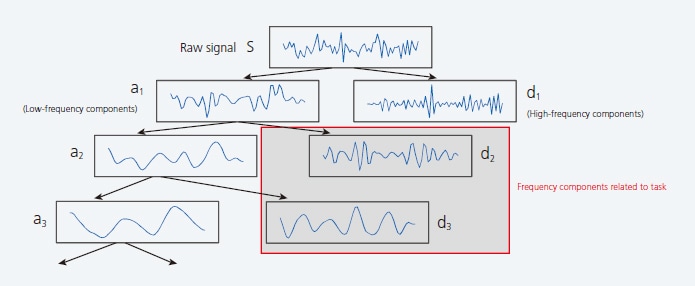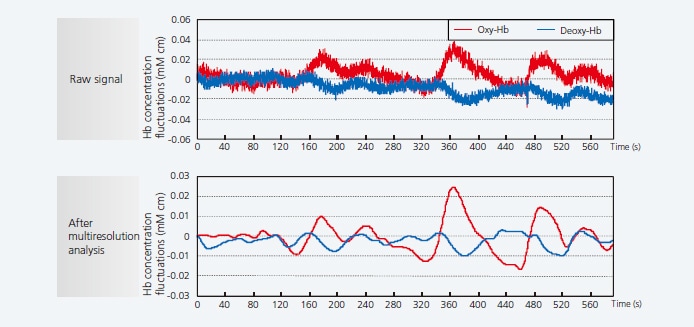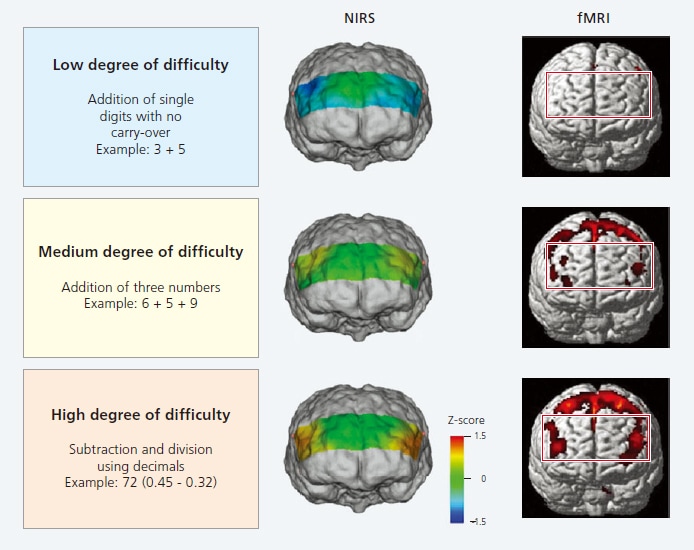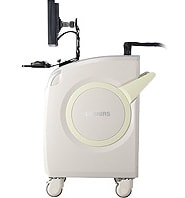NIRS Signal Analysis Method
Various non invasive methods are available to measure brain activity. One of these, functional magnetic resonance imaging (fMRI), has helped clarify higher order brain functions such as cognition and language. However, fMRI does not permit the subject's body, the head in particular, to move during measurements, which is problematic for brain function measurements in natural situations. At the same time, interests in near-infrared spectroscopy (NIRS) has increased in recent years. As NIRS permits brain function measurements in natural situations, it may support applications that fMRI cannot address. There is much debate about how to interpret signals obtained by NIRS, and it is problematic that no statistical signal processing method has yet been determined. Signals obtained by NIRS contain noise from the measurement instrument and effects from the subject's pulse, breathing and blood pressure fluctuations. Relative changes in NIRS signal values after the start of measurements make it difficult to compare data between subjects or to evaluate general trends during tasks.
Signal Processing by Multiresolution Analysis and Applying Standard Scores
A method is required to eliminate the signals unrelated to brain activity and to evaluate general brain activities during tasks. We have developed such a method. In the method, multiresolution analysis by discrete wavelet transform divides the NIRS signals into various frequency components, as shown in Fig. 1 The signal components corresponding to the task are then extracted and the signals are expressed as standard scores.

Fig. 1 Multiresolution Analysis
Fig. 2 shows a comparison between the raw signals and the signal components related to brain activity that were extracted by multiresolution analysis and reconstructed. It is apparent that the analyzed signals more clearly show the Oxy-Hb and Deoxy-Hb fluctuations.

Fig. 2 Comparison of Raw Signals and Signals After Multiresolution Analysis
This example shows the simultaneous measurement of brain activity by NIRS and fMRI while performing three arithmetic tasks with different degrees of difficulty. The method we developed was then used to create brain activity images. Standard scores were applied to the NIRS signals after multiresolution analysis and the signals from the nine subjects were averaged to create brain activity images. Fig. 3 shows comparisons between the fMRI and NIRS brain function images. Both show that the higher the degree of difficulty of the arithmetic task, the greater the activity of both lateral frontal lobes.

Fig. 3 Comparison of Brain Function Images by NIRS and fMRI (9 subjects)
Introduced here is a method of NIRS signal analysis using a combination of multiresolution analysis by discrete wavelet transform and applying standard scores. Simultaneous NIRS and fMRI brain function measurements were made while performing arithmetic tasks. Comparison of the fMRI results and the brain function images created by the method introduced here show similar trends. In the future, we hope to expand application of this method to tasks that are difficult to measure by fMRI, such as brain activity measurements on car drivers, and to the development of brain-computer interfaces (BCI) for operating equipment by thoughts alone.
(Data supplied by: Prof. H. Tsunashima, Department of Mechanical Engineering, College of Industrial Technology, Nihon University)
Note: The data shown was acquired using a FOIRE/OMM series model.
Related Products

LABNIRS
functional Near-Infrared Spectroscopy System for Research
The laboratory model is ideal for a wide variety of basic research fields.
With a broad range of possible measurement regions, it can be readily customized for specific experimental conditions.

LIGHTNIRS
Portable functional Near-Infrared Spectroscopy System for Research
The portable model is ideal for field research.
It expands the possibilities for measuring brain function in a diverse range of applications and research fields.


